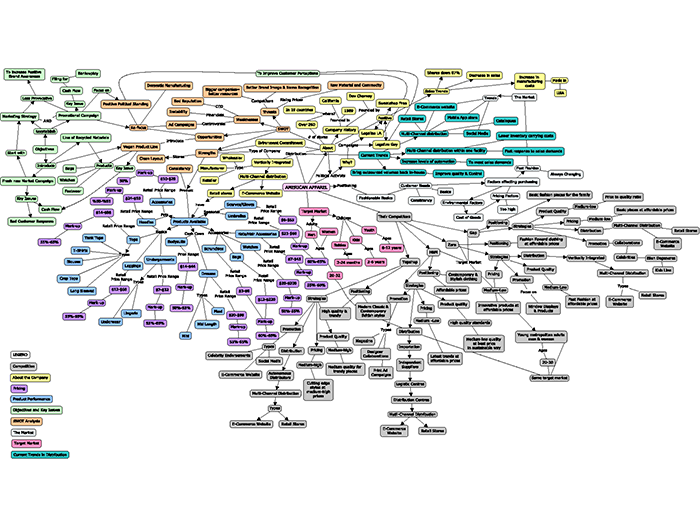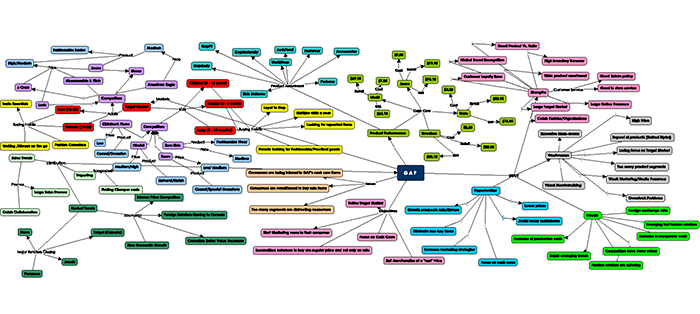Concept Mapping: A Great Instructional Strategy That Encourages Transfer of Knowledge and Critical Thinking
How the project came about
A while back, in a marketing strategy course of the Fashion Marketing Program, I integrated a project where students would identify the problems experienced by a fashion retailer who was struggling. They then had to propose solutions, find objectives and strategies and create an action plan. It became a very linear project for the students: 2 assignments of 20 marks each. The students would get into groups of 5 and divide up the work, “You do part A, you do part B and I’ll do part C…” etc. Each student would submit their part and the assignment had very little cohesiveness. I even had to tell the students to at least assign the proofreading of the entire work to one of the members of the group and make sure they all used the same font. I could tell which of the students were doing the work.
I decided to integrate software that would foster a more collaborative approach. I started using Cmap. I learned about concept mapping in a Performa course and I found it so much easier to go back to than typical notes. You are not always looking through your Word documents or Excel files, everything is in one place. In fact I found it so useful that I decided to apply the theory that I learned into one of my classrooms.
The students took a week or 2 to get used to the software. However, instead of wasting too much class time on this, I flipped the class and got the students to download the tool at home for free so they could begin to learn how to use it on their own.
I assigned a very easy project to practice at first: to create a fruit basket. The students listed the names of fruit to include in their concept map of a fruit basket, then they linked them to certain categories: berries, tropical fruit, fruit from orchards, etc. This assignment was easy for the students as they already have an extensive knowledge of the subject.
As they do some research for their fashion marketing project they include it right away in the concept map. Then as they go through the theory in the course they are just building, building, building… It’s an easy one-stop shop for them; they keep all of their knowledge in one place. Having a digital file is useful also as they can easily share their work with their teammates.
Advantages of this innovative practice
Students think of themselves as very tech-savvy and they are able to go retrieve their emails, find their documents on Google Docs and text messages, but I want to bring them a step further. I want them to realise that they have to think to use new software.
With the concept map they have a wonderful visual display of how they can find the problem and come up with solutions. What the students liked is that whenever they thought about either a new aspect of the problem or some innovative solutions they could easily add this to the group’s concept map. What the teacher in me liked was that the students were now working on the entire project and not just one part of it.
Another advantage is that it adapts to any type of learning style.

Students can color code their ideas (download the original PDF file to zoom in more clearly on specific parts of the mind map).
The great thing is that using this software really makes them reflect. I see the students go back to their map and change things. They can color code ideas. They control the narrative, which is the best thing. An advantage of this software is that as the concept map is created, concepts can be moved around, added, removed, and redefined.
There is definitely a transfer of knowledge as the students decide to reuse the software in other classes. Some students mentioned that they found it particularly useful to help them prepare for their comprehensive evaluation (épreuve synthèse).
With concept mapping you get an idea and it just grows.
Formative and summative evaluation

Students use their C-maps to review for the final evaluation (download the original PDF file to zoom in more clearly on specific parts of the mind map).
During the session, I sit down with the students to look at the work. If the students have any questions they can ask and they can use the feedback I give them to improve the Cmap before they submit it for evaluation.
For the review before the final evaluation the students bring their concept maps to class. The college implemented a BYOD policy and students often share their resources. Working in a group there are always one or 2 students who take on the task and then share the document with their teammates.
I noticed that after using this software in class there was a gain score at the final exam. In the course evaluation the project was worth 40%, the final 40% and class assignments were worth 20%. After all of the reflection that went into creating the concept map the students found that they were better able to remember the content for the exam and were also able to give more examples. They had learned the key concepts for the course.
A word to the wise
A tip I would give other teachers thinking about adding a software to their course is that some times integrating technology takes time to begin with. I found though that the time I put into learning the software and then into building the course I got that time back because this type of software seems to help students make the connections and come to a deeper understanding of the key concepts of the course. They transfer the theory into practice. Also I was not answering so many questions from the students. I think concept maps help students build better understanding and are well worth the time and effort.

